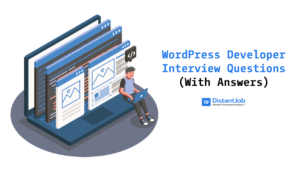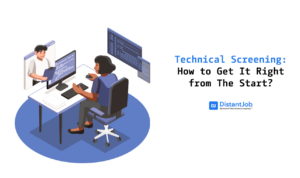Data scientists not only interpret data for organizations, but they build castles out of that data. Their diverse abilities and skills make them a high-demand profession that makes companies get into fierce competition for them. Recruiting this highly sought profession can be challenging, especially if you are not a technical recruiter or hiring manager.
How exactly do you hire a data scientist nowadays? The answer will depend on your needs and available resources, of course, but a great approach in the current market is to hire remotely. If you haven’t tried it, you should definitely consider it! You’ll immediately increase your hiring pool with high quality candidates at very competitive prices!
And to help you in your efforts, we present you a guide on how to hire a data scientist which will also cover the essential interview questions to ask. If you’re an employer looking to hire a data scientist or a job seeker, this guide is for you!
What Is Data Science?
When hiring a data scientist, you first need to understand what this profession is about. This means being able to differentiate it from other ‘’similar’’ disciplines, such as data analysis or data management.
Data Science builds upon the work performed by Data Management and Data Analysis. It uses a combination of math, statistics, programming, analytics reports, and Artificial intelligence (AI) / Machine Learning (ML) to glean information from a company’s data. This information can then be used to make better decisions and strategize how best to go forward so the company can grow.
Why Is Data Science Important For My Business?
Nowadays, companies house a lot of data just out of necessity, let alone by gathering it with the intent of using it for marketing, hiring, etc.
This information is usually stored as is and serves the purpose of allowing a company to do business. But all that information, when gathered, analyzed and operated upon, can lead to the implementation of positive changes in the way they do business. Here are just some of the ways data science can be used in your company:
- Glean insights from the data that can be used to improve processes and methodologies.
- Improve product design and engineering by analyzing end-users’ needs.
- Keep shareholders involved by communicating the findings of your analysis.
In short, by employing data scientists, you are making your information work for you and your company.
What is a Data Scientist?
Data scientists manage and read data, and also experiment and use different scientific methods with that data to achieve sustainable growth in companies. They build machine learning pipelines and personalized data products to help businesses understand their customers and make better decisions.
Data Scientist Skills and Qualifications
A data scientist’s skills will largely involve the reading, manipulation, and presentation of data. For that very purpose, they must be proficient in several fields and tools to work effectively:
- Mathematics
- Statistics and Statistical Analysis
- Data Mining
- Pattern Recognition and Predictive Modeling
- Programming (Java, Python, etc)
- SQL
- Analytics Tools and Platforms (Tableau, GoodData, etc)
- Office Tools (Spreadsheets and Presentations)
Data Scientist Roles and Responsibilities
Data scientists are responsible for generating value out of data. They are in charge of structuring and understanding massive amounts of data to provide insights and products. This helps businesses meet their needs, goals and automatize specific processes.
Their main responsibilities include:
- Select features, build and optimize classifiers using machine learning techniques.
- Identify valuable data sources and automate collection processes.
- Undertake data collection, preprocessing, and analysis.
- Analyze large amounts of information to discover trends or patterns.
- Propose solutions for the different challenges businesses face.
- Build predictive models and machine-learning algorithms.
- Present information and insights using data visualization techniques.
How to Hire a Data Scientist
Recruiting data scientists is hard. A few years ago, the profession of “data scientist” was relatively new. Few companies truly understood what the job was about and if it was important whether to hire them or not. Nowadays, as the world revolves around data, and thus most companies want to hire a data scientist.
According to Glassdoor’s 50 Best Jobs in America report, data scientists are ranked as the second-best job across every industry based on the job openings, salary, and overall job satisfaction ratings.
If you’re looking to hire data scientists but don’t know where to start, here are three strategies that will help you attract and recruit the talent you’re looking for:
1. Work on Your Job Description
Job descriptions are the first impression a candidate will have of your company, so it’s important to put your best foot forward. A job description can help potential candidates make up their minds whether they’ll enjoy the job or not, and apply to it.
All job descriptions should be straight to the point. Try to avoid weird expressions like ‘’rockstar data scientists.” Trust us, that will likely scare off the most talented ones. It’s always better to keep it simple and concise.
2. Offer Them The Benefits They Really Want
Make sure to accommodate your workers and give them the benefits they value more. Small benefits can bring your workers happiness, but they are more fleeting and do not have any weight when they are deciding whether they should take a job or not.
People have come to expect more of the benefits that a company can provide its workers. Remote work has become a staple in IT industries in recent years and people enjoy having the flexibility of working not only where they are more comfortable, but also where they are more productive. This is a net bonus for both the company and the worker.
3. Start Looking Globally
If you only look locally, you are severely limiting your options. You might be lucky enough to have great talent a few blocks away from you but honestly this is very rare, especially when we’re talking about data scientists.
Hiring remote data scientists is your chance to bring the best talent to your team. You get to choose from many different countries in the world, and the best of all is that you not only select talented candidates, but you also save money doing so. Costs of living are different in every country!
8 Interview Questions To Ask Your Data Scientist
Here are the best data scientist interview questions to test their knowledge and technical abilities.
1. What Are The Differences Between Supervised And Unsupervised Learning?
Supervised machine learning uses known and labeled data as input, and it has a feedback mechanism. The most commonly used supervised learning algorithms are decision trees, logistic regression, and support. On the other hand, unsupervised machine learning uses unlabeled data as input, and it doesn’t have a feedback mechanism. Its most commonly used algorithms are k-means, clustering, hierarchical clustering, and apriori algorithms.
2. Explain The Main Steps In Making A Decision Tree
There are 5 main steps in making a decision tree:
- Take the entire data set as input.
- Calculate entropy of the target variable and the predictor attributed.
- Calculate the information gain of all attributes.
- Choose the attribute with the highest information gain as the root node.
- Repeat the same procedure on every branch until the decision node of each branch is finalized.
3. What Are The Feature Selection Methods Used To Select The Right Variables?
There are two feature selection methods to select the right variables:
Filter methods involve linear discrimination analysis, ANOVA, and Chi-Square. When we’re selecting the features, it’s all about cleaning the data coming in.
Wrapper methods involve forward selection (to test one feature at a time), backward selection (test all the features and start removing them to see what works better), and recursive feature elimination (recursively look at all the different features and how they pair together).
4. What Does p-value Mean?
When you are performing a hypothesis test in statistics, a p-value can help you determine how strong your results are. p-value is a number between 0 a 1 and based on this value you’ll know the strength of the results. For instance:
- Low p-value (≤ 0.05) indicates strong evidence against the null hypothesis which means you can reject the null hypothesis.
- High p-value (≥ 0.05) indicates weak evidence against the null hypothesis, which means you can accept the null hypothesis.
- p-value at 0.05 is considered as marginal; you can both accept or reject the null hypothesis.
5. What Is A Random Forest?
A random forest is a versatile machine learning method that performs both regression and classification tasks. It involves creating multiple decision trees using bootstrapped datasets of the original data and randomly selecting a subset of variables at each decision tree step. The model then chooses the mode of all predictions of each decision tree.
By relying on a majority wins model, it reduces the risk of error from an individual tree.
Random forests offer several benefits such as strong performance, non-linear boundaries, cross-validation is not necessary, and gives feature importance.
6. You Randomly Draw A Coin From 100 Coins – 1 Unfair Coin (Head-head), 99 Fair Coins (Heat-tail), And Roll It 10 Times. If The Result Is 10 Heads, What Is The Probability That The Coin Is Unfair?
This can be answered using the Bayes Theorem. The extended equation for the Bayes Theorem is the following:

Assume that the probability of picking the unfair coin is denoted as P(A) and the probability of flipping 10 heads in a row is denoted as P(B).
P(B | A)= 1
P(B ∣ ¬A) = 0.5¹⁰ = 0.0009765625
P(A) is equal to 0.01
P(¬A) is equal to 0.99
If you fill in the equation, then P(A | B) = 0.9118432769 or ≈ 91.18%.
7. How Do You Handle Missing Data?
To handle missing data, the first step is to determine the percentage of data missing in a specific column. That way, it’s better to choose the appropriate strategy to handle the situation. For example, if most of the data is missing in a column, then dropping the column is the best option unless we have some means to make educated guesses about the missing values.
However, if the data missing is low, there are several ways to fill them up. One strategy is to fill them up with a default value or a value with the highest frequency in that column, such as 0 or 1, etc. Another way is to fill up the missing values in the mean of all the values in that column. This technique is the most popular one as the missing values have a higher chance of being closer to the mean than to the mode.
8. Explain cross-validations
Cross-validation is essentially a model validation technique used to evaluate how the outcomes of a statistical analysis will generalize to an independent data set. It’s mainly used in backgrounds where the objective is to forecast, and you want to estimate how accurately a model will accomplish in practice.
Recruit a Remote Data Scientist With DistantJob!
If you want to hire a talented remote data scientist at an affordable price and as soon as possible, we’re your best option. As a boutique remote recruiting agency, DistantJob has been in the business for more than 10 years.
We know where the best IT candidates hide, and we know how to attract them by having the best IT recruitment strategy, so why don’t you leave this to us? Contact us, tell us all about your ideal data scientist, and in less than a month, you’ll be having an engineer with the right skills for the job role.
And if you are a data scientist looking for a job, feel free to contact us or to check our remote job openings board.





